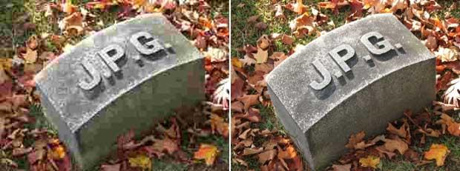The JPEG format is one of the most common file formats for digital pictures. JPEG stands for Joint Photographic Experts Group, which is the name of the group that created the popular file standard.
One of the reasons the JPEG file format is so popular is because of its compression capabilities. With a JPEG image you can achieve significant file compression without sacrificing too much image quality. This means a JPEG file can be compressed to a smaller file size, thus saving storage space, without causing the image to lose quality.
JPEG files are able to accomplish this compression with a process called "lossy". Although there are many complicated algorithms and computations behind lossy compression, the basic explanation of what occurs is:
Keep in mind this does not mean you can compress a file and maintain the exact same image quality. You will inevitably lose some quality when any image type is compressed. However, JPEG files are designed to be compressed, which allows for a smaller file whose size depends on the amount of compression. In other words, if a JPEG is only compressed a little the file size and quality will also only reduce a little. If the JPEG is significantly compressed though, the file size would be much smaller and the new image quality would also be reduced.
The best way to point this out is with example images. Look at the two images below from www.nycaviation.com:

The image on the left is a more compressed, and thus smaller sized, JPEG image. You should notice the colors are not as sharp and the stone block has some discoloration. This was caused by compressing the image to a smaller size.
By contract, the image on the right was not compressed as much. This yields a higher quality image, which also means a larger file size. The colors are more distinct and the stone does not have as much discoloration.
But, the differences between the two are not overly noticeable. This is the beauty of JPEG. By using lossy editing the lesser important parts of the image can be "lost", yielding a slightly lower quality image but also giving you a much smaller sized image.
If you use a digital camera or spend much time on the Internet you have probably come across hundreds or thousands of JPEG images. This is because the JPEG format works extremely well for color, grayscale and monochrome images – which is pretty much every image out there!
Although the standard file extension for a JPEG file is .JPEG, the same standards are applied and used with .jpg, .jpe, .jfif, and .jfi files. The next time you open up an email that has a picture attached to it, or you are browsing a web page, check out the properties of the picture. Chances are you will see one of those file extensions.
Another reason the JPEG file format is so widely popular is because of how accessible it is. JPEG images are recognized by virtually every device and software reader like Adobe and Word, as well as all Internet browsers and photo/image software available today.
Check your camera or phone and you will most likely find it is full of JPEG images. There's a reason it is so easy to download the photos to a computer or to send them in a message or email. It is because the JPEG standard is so widely recognized and used that you probably won't be able to find a device or program that won't let you display one of the images.
Because of its compression abilities and widely recognized format, the JPEG file will be around for a long time. Although other image formats like GIF and PNG are used today, the JPEG format is recognized as superior because of its image quality for full color and realistic scenes. In other words, JPEG files are perfect for photos!
JPEG files also let you find a balance between compression (file size) and quality, which is another reason the format is here to stay. When editing or working with a photo you can change the compression and see what the resulting image looks like. By doing this you can find the perfect balance between taking up space on your device and the quality of your favorite images and photos.
We hope this article has given you a good overview of the JPEG file format, why it is so popular, and some of the benefits of using it. Check back regularly for more information about images and software products to make using and converting images, like JPEG files, easier than ever before.